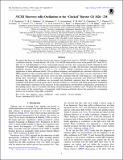NICER Discovers mHz Oscillations in the "Clocked" Burster GS 1826−238
Author(s)
Strohmayer, T. E.; Gendreau, K. C.; Altamirano, D.; Arzoumanian, Z.; Bult, P. M.; Chenevez, J.; Guillot, S.; Guver, T.; Homan, J.; Jaisawal, G. K.; Keek, L.; Mahmoodifar, S.; Miller, J. M.; Ozel, F.; Chakrabarty, Deepto; ... Show more Show less
DownloadStrohmayer_2018_ApJ_865_63.pdf (819.9Kb)
PUBLISHER_POLICY
Publisher Policy
Article is made available in accordance with the publisher's policy and may be subject to US copyright law. Please refer to the publisher's site for terms of use.
Terms of use
Metadata
Show full item recordAbstract
We report the discovery with the Neutron Star Interior Composition Explorer (NICER) of mHz X-ray brightness oscillations from the "clocked burster" GS 1826-238. NICER observed the source in the periods 2017 June 20-29, July 11-13, and September 9-15, for a total useful exposure of 34 ks. Two consecutive dwells obtained on 2017 September 9 revealed highly significant oscillations at a frequency of 8 mHz. The fractional, sinusoidal modulation amplitude increases from 0.7% at 1 keV to ≈2% at 6 keV. Similar oscillations were also detected at lower significance in three additional dwells. The oscillation frequency and amplitude are consistent with those of mHz QPOs reported in other accreting neutron star systems. A thermonuclear X-ray burst was also observed on 2017 June 22. The burst properties and X-ray colors are both consistent with GS 1826 being in a soft spectral state during these observations, findings that are confirmed by ongoing monitoring with MAXI and SWIFT-BAT. Assuming that the mHz oscillations are associated with blackbody emission from the neutron star surface, modeling of the phase-resolved spectra shows that the oscillation is consistent with being produced by modulation of the temperature component of this emission. In this interpretation, the blackbody normalization, proportional to the emitting surface area, is consistent with being constant through the oscillation cycle. We place the observations in the context of the current theory of marginally stable burning and briefly discuss the potential for constraining neutron star properties using mHz oscillations. Key words: stars: neutron – stars: oscillations – stars: rotation – X-rays: binaries –
X-rays: individual (GS 1826,238)
Date issued
2018-09Department
Massachusetts Institute of Technology. Department of PhysicsJournal
The Astrophysical Journal
Publisher
American Astronomical Society
Citation
Strohmayer, T. E., K. C. Gendreau, D. Altamirano, Z. Arzoumanian, P. M. Bult, D. Chakrabarty, J. Chenevez, et al. “NICER Discovers mHz Oscillations in the ‘Clocked’ Burster GS 1826−238.” The Astrophysical Journal 865, no. 1 (September 21, 2018): 63. © 2018 The American Astronomical Society.
Version: Final published version
ISSN
1538-4357